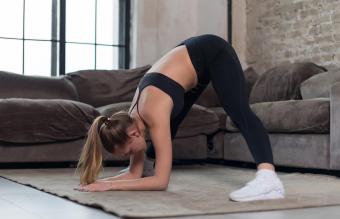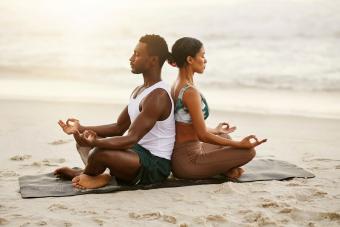
According to Gaiam Life, the moon has a great deal of feminine energy and is considered to be quite intuitive and receptive. As the moon reflects the sun, moon poses - including half moon pose - may help us reflect on parts of the psyche that people may otherwise try to keep under wraps.
Performing Half Moon
- Stand tall at the top of your mat, with your feet positioned closely together and your toes facing forward.
- Take a large step backward with your right foot, rotating your right hip so that your right toes are facing the side of the mat, your hips are facing the side of the mat, and your left toes are still facing forward.
- Keeping your shoulders relaxed, raise your arms and position them in a "T" with your palms facing down.
- Place your right hand on your waist.
- Carefully bend your left knee, slowly shifting your weight onto your left leg as you raise your right foot from the ground. Elevate the right leg until it is parallel to the floor or slightly higher.
- Keep equal pressure on the inner and outer arch, forefoot, and heel of the left foot that remains in contact with the ground, and straighten the left knee.
- Lower your left hand to the floor, positioning it about 12-inches in front of your left foot and directly below your shoulder. Spread your fingers wide and focus on an unmoving gaze point to help maintain your balance.
- To lengthen the spine and neck, imagine a string pulling the top of your head toward the wall in front of you.
- Extend your right arm toward the sky with your palm facing the same direction as your right toes. Turn your gaze to the side wall or to your right hand, if you like.
- Take at least five deep breaths.
- To exit half moon pose, exhale while looking down toward your left foot, lower your right hand to your waist, and carefully lower the right foot back to the floor.
- Inhale as your raise up to a standing position.
- Repeat half moon pose on the other side of the body.
Modifications
Even the most novice yogis can perform half moon pose by incorporating some basic modifications.
Musculoskeletal Injury or Tightness
Individuals who experience tightness in their hamstrings or lower back may want to make modifications when performing half moon pose. Instead of placing your left hand directly on the floor, Gaiam TV recommends that beginning yogis or those with musculoskeletal weakness or injuries rely on the use of yoga blocks.
Place your hand on the yoga block in one of three ways to prevent injury when performing half moon pose, recommends Gaiam TV. As your flexibility increases, you can gradually wean yourself from the use of this equipment.
Balance Challenges
Women's Health notes that beginning yoga enthusiasts who experience difficulty when it comes to keeping their balance may want to perform half moon pose up against a wall. This will help you find and keep your alignment and can be especially helpful for those trying the pose for the first time.
For optimal results when it comes to this modification, Women's Health encourages exercisers to press their entire body into the wall.
Maximizing Half Moon
In addition to promoting a greater recognition of emotions, half moon pose provides a number of physical benefits. In fact, Shaw notes that half moon pose can be helpful when it comes to building core and shoulder strength, hamstring and lower back flexibility, and concentration.
Individuals who suffer from musculoskeletal injury or face difficulty when it comes to maintaining balance should not shy away from incorporating basic pose modifications. As pose proficiency increases, the use of the tools can be decreased.







